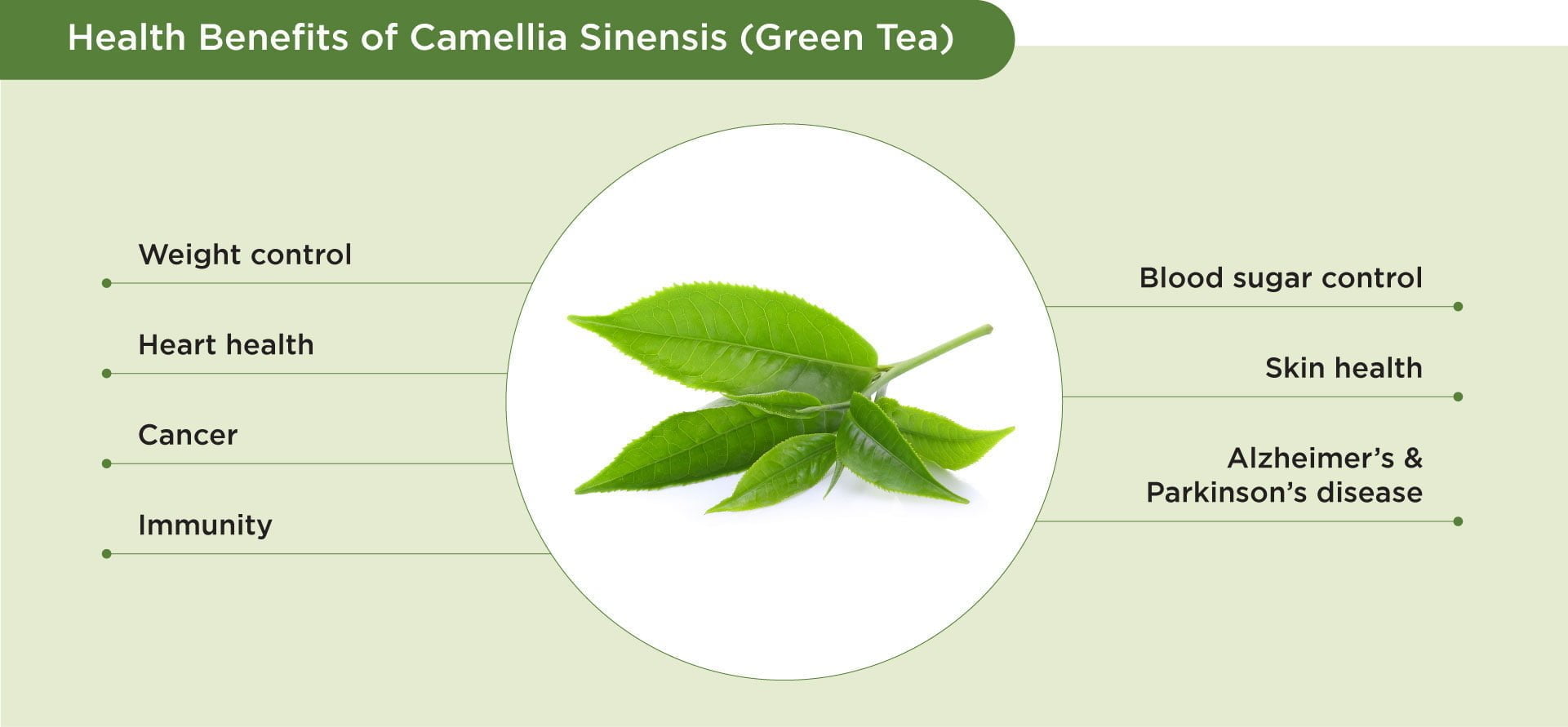Camellia sinensis (Green Tea)

Camellia sinensis (Green tea)
Camellia sinensis, also known as tea, is one of the most popular beverages consumed worldwide. Camellia sinensis belongs to the Theaceae family, native to Southeast Asia, but today is also cultivated in Sri Lanka and Japan. Tea can be classified into green, white, yellow, oolong, black, and dark tea with the difference lies in the way they are processed 1. The processing plays an important role in developing the main features and properties of Camellia sinensis. For example, Green tea is derived from mature leaves of Camellia sinensis and processed before oxidation. White tea is freshly air-dried and contains a high amount of antioxidants, and Black tea is fully oxidised and more popular in Western Country 1.
Nutritional Facts
Camellia sinensis contains vitamins and minerals such as vitamin B, vitamin C, vitamin E, calcium, magnesium, chromium, iron, copper, zinc, selenium, manganese, sodium, phosphorus, potassium, fluorine, strontium, and molybdenum 2. Fresh tea leaves are rich in polyphenols, especially flavanols, also commonly known as catechins 2. Camellia sinensis also contains alkaloids including caffeine, theobromine, and theophylline, which provide the stimulant effects 1,2.
Published Health Benefits
1. Weight Control
Camellia sinensis extract like caffeine and epigallocatechin (EGCG), may boost metabolism and reduce body weight mainly body fat 1,2. White tea and green tea both effective when it comes to burning fat as both teas have similar levels of caffeine and catechins 1.
2. Heart Health
The antioxidant properties of polyphenols help to reduce the risk of heart disease in several ways. Polyphenols may help to relax the blood vessels, reducing vascular inflammation, and improve blood flows to the heart 3. Polyphenols also reduce “bad” LDL cholesterol by preventing LDL cholesterol from becoming oxidised and prevent fat storage in the liver 1,3.
3. Cancer
Camellia sinensis has powerful antioxidants such as polyphenols, catechins, and EGCG that may protect against cancer 3. Studies had shown that Camellia sinensis exerts a significant anticancer effect against many different types of cancer such as lung cancer, breast cancer, prostate cancer, bladder cancer, and skin cancer 3,4.
4. Immunity
EGCG in Camellia sinensis leaf extract possesses antibacterial and antiviral effects which may boost the immune system and help the body in fighting infections and viruses 3.
5. Blood Sugar Control
Camellia sinensis enhances insulin activity due to EGCG 3. EGCG is known to have an antioxidant property that is effective in reducing the effects of insulin resistance by decreasing the digestions and absorption of carbohydrates 3,5.
6. Skin Health
Camellia sinensis leaf extract in the form of green tea has the ability in protecting the skin from UV-induced damage and skin inflammation 6. Green tea is also effective in hydrating the skin and improves its structure and quality. Camellia sinensis extract in the form of white tea is rich in antioxidants, which contribute to skin nourishment and maintaining healthy and youthful skin.
7. Alzheimer’s and Parkinson’s Disease
Catechin Polyphenols in Camellia sinensis have anti-inflammatory and antioxidant effects 1.7. It helps to reduce oxidative stress and inflammation in the brain, thereby protect the brain cells and delay the deterioration caused by Alzheimer’s and Parkinson’s Disease 7.
References:
1. Zhang, L., Ho, C., Zhou, J., Santos, J. S., Armstrong, L., & Granato, D. (2019). Chemistry and Biological Activities of Processed Camellia sinensis Teas: A Comprehensive Review. Comprehensive Reviews in Food Science and Food Safety, 18(5), 1474-1495. doi: 10.1111/1541-4337.12479
2. Chacko, S. M., Thambi, P. T., Kuttan, R., & Nishigaki, I. (2010). Beneficial Effects of Green Tea: A Literature Review. Chinese medicine, 5, 13. https://doi.org/10.1186/1749-8546-5-13
3. Aboulwafa, M. M., Youssef, F. S., Gad, H. A., Altyar, A. E., Al-Azizi, M. M., & Ashour, M. L. (2019). A Comprehensive Insight on the Health Benefits and Phytoconstituents of Camellia sinensis and Recent Approaches for Its Quality Control. Antioxidants (Basel, Switzerland), 8(10), 455. https://doi.org/10.3390/antiox8100455
4. Chopade, V., Phatak, A., Upaganlawar, A., & Tankar, A.A. (2008). Green tea (Camellia sinensis): Chemistry, Traditional, Medicinal uses and its Pharmacological activities- A Review. Pharmacognosy Reviews, 2, 157.
5. Park, J. H., Bae, J. H., Im, S. S., & Song, D. K. (2014). Green tea and type 2 diabetes. Integrative medicine research, 3(1), 4–10. https://doi.org/10.1016/j.imr.2013.12.002
6. Rhodes, L. E., Darby, G., Massey, K. A., Clarke, K. A., Dew, T. P., Farrar, M. D., Bennett, S., Watson, R. E., Williamson, G., & Nicolaou, A. (2013). Oral green tea catechin metabolites are incorporated into human skin and protect against UV radiation-induced cutaneous inflammation in association with reduced production of pro-inflammatory eicosanoid 12-hydroxyeicosatetraenoic acid. The British journal of nutrition, 110(5), 891–900. https://doi.org/10.1017/S0007114512006071
7. Kakutani, S., Watanabe, H., & Murayama, N. (2019). Green Tea Intake and Risks for Dementia, Alzheimer’s Disease, Mild Cognitive Impairment, and Cognitive Impairment: A Systematic Review. Nutrients, 11(5), 1165. https://doi.org/10.3390/nu11051165








